

Visit my Home Page.
Want to send me mail? Click here: tomrdavis@earthlink.net.
We made a slideshow of our better photos, and this webpage is basically just that slideshow, together with the comments we might make as each slide appears. You can click on any of the thumbnails below to obtain the full-sized (1280x800 pixel) slide.
The subheadings below correspond to the sections of our slide show. Some of the photos are great, but some are pretty crappy, since the bird was far away, or it was moving, or it was too dark, or some combination of the three. Luckily for you readers, the really crappy photos do not appear.
Almost the whole trip schedule was arranged by Nang, an ex-girlfriend of Chris whom he recommended highly. Here's her webpage:
She runs general tours for anyone who wants to visit Thailand but is particularly good at birding, so she was a particularly good choice for us. Her English is fantastic (she lived in the US for years), and she is a very enthusiastic birder. In fact, sometimes too enthusiastic for us: at the end of the day, we were sometimes pretty wiped out, but she had lots more to show us, and we'd just tell her to call it a day.
This was the first time either Ellyn or I had been to Asia, and we knew the birding would be difficult. Almost all our birding experience has been in the Americas (Costa Rica, Belize, Ecuador, Peru, Brazil, Argentina, Trinidad and Tobago, oh, and the US and Canada as well), so when we visit a new country in Central or South America there will, of course, be new birds, but at least we know almost all the families, and have some idea of where to look in the bird guides. In Thailand, there was family after family of birds we'd never seen, except perhaps in zoos or in National Geographic specials on television: Drongos, Bulbuls, Mynas, Hornbills, Babblers, Treepies, Bee-eaters, Sunbirds, and on and on. So it was just like being a total beginner at times: start on page 1 of the bird guide, then try page 2, ...
Almost every bird we saw was a "life bird" or "lifer" (the first time you see a bird in the wild, it's called a "life bird"). We saw, in total, about 230 species, and probably 210 or 215 of them were lifers. Of course, since everything was new, and we were not into doing a lot of bird homework before we went, at first we didn't know which were common birds and which were difficult. We counted on Nang for this, but it was a little disconcerting sometimes when we'd be looking at a really cool bird and Nang would suddenly jerk our attention away to one that wasn't nearly as cool, but was much rarer.
Here is a complete list of the birds we saw.
Another birding term that's sort of the opposite of "lifer" is "trash bird". A trash bird is one that you see so often that you're almost sick of seeing it again. Or, if you're the worst sort of birder who's only interested in getting new birds for his "life list", a trash bird is any bird you see for the second time. A trash bird can be incredibly beautiful. There were not too many interesting birds that became trash birds for us, but the Common Myna, the Ashy Drongo and the Asian Openbill began to fit into that category after a while.
I was trying to get good photos of as many birds as possible; both the common ones and the rare ones, but I did get mixed up and although I had lots of opportunities at some common ones, I forgot which ones I had good photos of and which ones I hadn't. For example, one of the most common birds is called the "Common Myna", and we saw hundreds of them, many in great positions for a photo, but I never took one since after a couple of days, having seen so many, I felt sure that I must have a good photo.
I'm more into bird photography than birding, so I spent a large proportion of my time hauling around a heavy camera, tripod and lens. When we sighted a bird, I had to set down the tripod carefully, and because of that I often missed birds that Ellyn got a good look at. Or sometimes I'd be trying to get a good photo when another bird showed up. If the photo opportunity seemed good, I sometimes just ignored the new bird to get the photo, and by the time I was done with the camera, the new bird was gone. I probably missed about 20 birds because of that, or about one in 10.
I used a relatively new Nikon D3 camera, the Nikon 200-400mm f/4 lens with VR (vibration reduction). I also had a 1.4x "doubler" which converted the lens to an effective 280-56mm f/5.6, but something was wrong with the lens-doubler-camera combination and I couldn't use the doubler although the camera worked fine with the lens. A year earlier (on my last major bird-photography trip to Florida) the tripod head broke off while I was carrying it and the camera-doubler-lens combination crashed to the ground. The lens seemed to work fine with my backup camera, so all I had repaired was the camera. I should have checked things more thoroughly before going. The other "problem" is that the D3 is a "full-frame" DSLR, as opposed to most cameras that have an effective 1.5x "multiplier". So with the older cameras, I was used to having an effective 300-600mm lens without the doubler. On this trip, with the D3 and the unusable doubler, I could only get about 1/4 the resolution I was used to. The D3, however, has much "better" pixels, so I could enlarge them more than I could in the past. I still missed the doubler, however.
This was my first trip to Asia, and in addition, my first trip to a country where I had absolutely no clue about the language. Unless you do some study, you can't even sound out the names on the signs. From the bizarre nature of the translations we did see, I can only conclude that English and Thai are very different. I'm sure if I tried to learn to speak Thai, my sentences would sound totally bizarre to them.
Of course Thailand is a "third world country", but one thing that impressed me there was that cell phones worked a lot better there than I'm used to in the United States. I live in "silicon valley", which you'd expect to be totally high-tech, but there are plenty of places in town and nearby where there's no reception. But in Thailand, even out in the boondocks of the national parks, the cell phones usually worked.
Bottom line: Thailand is a great country to visit, at least the parts we saw. We did not, however spend any time in big cities, other than what was required to get through them. Ellyn and I took almost no care with what we ate and drank, other than drinking bottled water, and we did use ice a lot. I had no GI troubles for the entire trip, and Ellyn had one bad day. The roads were pretty good as well. Luckily, we didn't need to test the police or medical services.
On second thought, I take that back: we did have an encounter with police services. Our driver was on one of the fast highways heading north and we were flagged down by cops. He was apparently speeding (I don't doubt that), and the cop informed us that the fine was 400 baht (about $12) that we could pay by going to the police headquarters in the nearby town, having everything recorded normally, and that would be it. OR, we could just pay him 100 baht and no record of the incident would be made. We went with the 100 baht. Apparently the cops are all terribly underpaid and this is how they augment their salaries.
OK, enough delay: on with the slide show!


 Limestone Wat This is the opening slide for the show. A "wat" is a buddhist temple, and they were all over the place and often very beautiful. There are as many wats in Thailand as Churches in Central/South America, but the difference is that apparently it's not a legal requirement in Thailand to have a soccer field in front of every wat. Actually, this was our first stop in "real" Thailand; we didn't stop to see the wat, although it was nice. We stopped there to look for a special, hard-to-find bird: the Limestone Wren-Babbler (which we did see, but which I didn't get a photo of).
Limestone Wat This is the opening slide for the show. A "wat" is a buddhist temple, and they were all over the place and often very beautiful. There are as many wats in Thailand as Churches in Central/South America, but the difference is that apparently it's not a legal requirement in Thailand to have a soccer field in front of every wat. Actually, this was our first stop in "real" Thailand; we didn't stop to see the wat, although it was nice. We stopped there to look for a special, hard-to-find bird: the Limestone Wren-Babbler (which we did see, but which I didn't get a photo of).
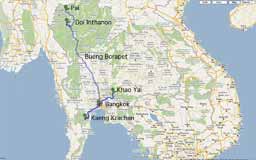 Thai Map We flew from San Francisco to Tokyo and then from there to Bangkok. Nang met us with our driver for the trip (Ahn) late at night, and we drove to a nearby hotel. Almost all the trip was by car from national park to national park. We visited each park (Khao Yai, Kaeng Krachan and Doi Inthanon) for about three days each, but stopped at interesting sites between them. The long drive was between Kaeng Krachan and Doi Inthanon, and there is the Bueng Borapet "Non-Hunting Area" about half-way between where we spent a night. All of this part of the trip involved mostly birding and bird photography. Then we drove from Doi Inthanon to Pai to visit our friends Chris and Paul, and spent a few relaxing days there. We then took a car from Pai to Chiang Mai and from there a flight to Bangkok. We spent the night in the airport hotel and flew home the next day.
Thai Map We flew from San Francisco to Tokyo and then from there to Bangkok. Nang met us with our driver for the trip (Ahn) late at night, and we drove to a nearby hotel. Almost all the trip was by car from national park to national park. We visited each park (Khao Yai, Kaeng Krachan and Doi Inthanon) for about three days each, but stopped at interesting sites between them. The long drive was between Kaeng Krachan and Doi Inthanon, and there is the Bueng Borapet "Non-Hunting Area" about half-way between where we spent a night. All of this part of the trip involved mostly birding and bird photography. Then we drove from Doi Inthanon to Pai to visit our friends Chris and Paul, and spent a few relaxing days there. We then took a car from Pai to Chiang Mai and from there a flight to Bangkok. We spent the night in the airport hotel and flew home the next day.
It's a little strange, I guess, that we saw almost nothing of any big cities in Thailand (Pai is tiny). We had originally thought that we'd get a place in Bangkok for the last night and at least have a few hours there, but the Bangkok airport is about 30 km from the city, we had an early flight the next day, and just decided to do the lazy thing.
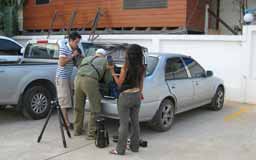 Transport Here's the car we traveled in. Nang borrowed it from her uncle. She and the driver were in the front seats which worked out well since Nang is about 1000 times better than we are at spotting birds. It was a little crowded in the back, especially when I had all my camera gear and we both had our binoculars.
Transport Here's the car we traveled in. Nang borrowed it from her uncle. She and the driver were in the front seats which worked out well since Nang is about 1000 times better than we are at spotting birds. It was a little crowded in the back, especially when I had all my camera gear and we both had our binoculars.
 Cook Here was the cook at an outdoor restaurant where we had our first meal in Thailand. We just pointed to the stuff we wanted in our meal and she cooked it all up. We even had a pretty decent latte and cappuccino afterwards! OK, not from her, but from the next-door coffee house.
Cook Here was the cook at an outdoor restaurant where we had our first meal in Thailand. We just pointed to the stuff we wanted in our meal and she cooked it all up. We even had a pretty decent latte and cappuccino afterwards! OK, not from her, but from the next-door coffee house.
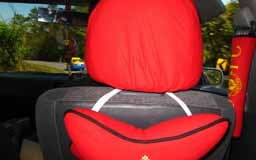 Ellyn's View This was Ellyn's view ahead during the trip. Mine was similar.
Ellyn's View This was Ellyn's view ahead during the trip. Mine was similar.

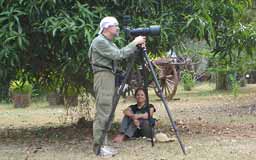 Tom, Nang and Camera Here's a photo of me with my usual camera setup.
Tom, Nang and Camera Here's a photo of me with my usual camera setup.
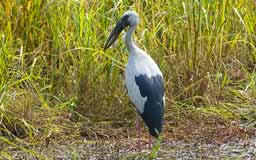 Asian Openbill (Anastomas oscitans) This was a very common stork. We'd often see hundreds of them flying in circles in the sky. They spent a lot of time eating snails and similar in the rice paddies.
Asian Openbill (Anastomas oscitans) This was a very common stork. We'd often see hundreds of them flying in circles in the sky. They spent a lot of time eating snails and similar in the rice paddies.
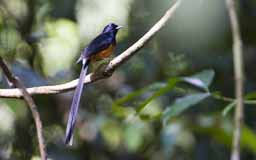 White-rumped Shama (Copsychus malabaricus)
White-rumped Shama (Copsychus malabaricus)
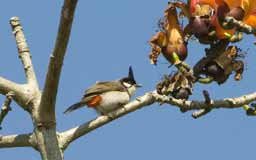 Red-whiskered Bulbul (Pycnonotus jocosus)
Red-whiskered Bulbul (Pycnonotus jocosus)
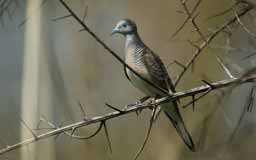 Peaceful Dove (Geopelia striata) This is a crappy photo but when I took it, I discovered the problem with my doubler. The doubler kept the aperture wide-open, and so the shot is totally overexposed (by at least 3 stops). I corrected as well as I could in Photoshop, but the bird is much prettier than this image makes it seem.
Peaceful Dove (Geopelia striata) This is a crappy photo but when I took it, I discovered the problem with my doubler. The doubler kept the aperture wide-open, and so the shot is totally overexposed (by at least 3 stops). I corrected as well as I could in Photoshop, but the bird is much prettier than this image makes it seem.
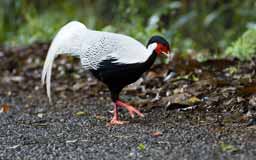 Male Silver Pheasant (Lophura nycthemera) This is a "good" bird: sometimes hard to find, but we were a bit lucky. We got up very early and drove into the park since this bird usually is hidden in the forest later in the day. We found two males and a female crossing the road. The males gave me much better photo opportunities, as you can see. The female was a lot more timid and I only got one half-decent photo, below.
Male Silver Pheasant (Lophura nycthemera) This is a "good" bird: sometimes hard to find, but we were a bit lucky. We got up very early and drove into the park since this bird usually is hidden in the forest later in the day. We found two males and a female crossing the road. The males gave me much better photo opportunities, as you can see. The female was a lot more timid and I only got one half-decent photo, below.
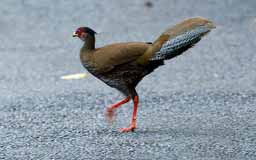 Female Silver Pheasant (Lophura nycthemera)
Female Silver Pheasant (Lophura nycthemera)
 Asian Emerald Cuckoo (Chrysococcyx maculatus)
Asian Emerald Cuckoo (Chrysococcyx maculatus)
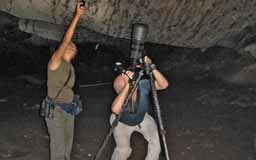 Bat Shooting Here I am, in a cave, trying to take photos of the bats on the ceiling. I took a lot of photos, but with very little light, focus was difficult. Luckily, with lots of tries, a couple of them came out ok. The ceiling was pretty high up.
Bat Shooting Here I am, in a cave, trying to take photos of the bats on the ceiling. I took a lot of photos, but with very little light, focus was difficult. Luckily, with lots of tries, a couple of them came out ok. The ceiling was pretty high up.
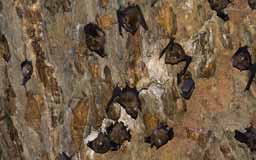 Bat Cave Here's a photo that's not bad.
Bat Cave Here's a photo that's not bad.
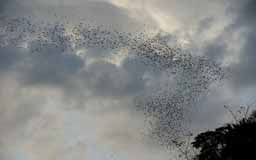 Bat Flight Later that evening we went to another site where there's a bat cave that's much less accessible, but literally millions of bats came out in the evening. This is one snapshot, but the exodus went on for about a half-hour.
Bat Flight Later that evening we went to another site where there's a bat cave that's much less accessible, but literally millions of bats came out in the evening. This is one snapshot, but the exodus went on for about a half-hour.
 Barking Deer (Muntiacus muntjak)
Barking Deer (Muntiacus muntjak)
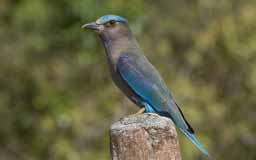 Indian Roller (Coracias benghalensis)
Indian Roller (Coracias benghalensis)
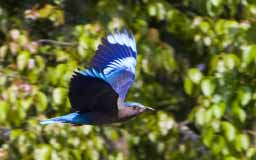 Indian Roller (Coracias benghalensis) We found this guy sitting on a signpost and cooperatively making little flights out and back. I got a bunch of chances to get him (or her) in flight, and this is one of the better ones.
Indian Roller (Coracias benghalensis) We found this guy sitting on a signpost and cooperatively making little flights out and back. I got a bunch of chances to get him (or her) in flight, and this is one of the better ones.
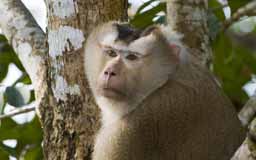 Pig Tailed Macaque (Macaca nemestrina) In Khao Yai these were all over the place, and were very tame. As we drove by in cars, they'd come out on the road and beg. In the next photo, you can see why they're called "pig-tailed."
Pig Tailed Macaque (Macaca nemestrina) In Khao Yai these were all over the place, and were very tame. As we drove by in cars, they'd come out on the road and beg. In the next photo, you can see why they're called "pig-tailed."
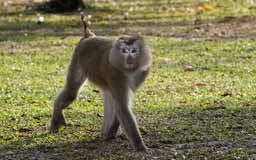 Pig Tailed Macaque (Macaca nemestrina)
Pig Tailed Macaque (Macaca nemestrina)
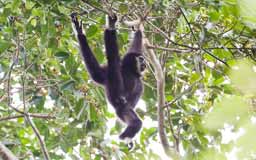 White-handed Gibbon or Lar Gibbon (Hylobates lar)
White-handed Gibbon or Lar Gibbon (Hylobates lar)
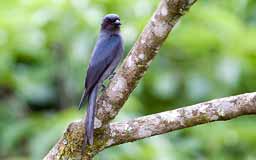 Ashy Drongo (Dicrurus leucophaeus)
Ashy Drongo (Dicrurus leucophaeus)
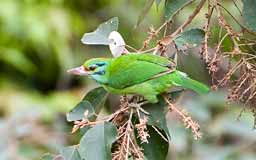 Moustached Barbet (Megalaima incognita)
Moustached Barbet (Megalaima incognita)
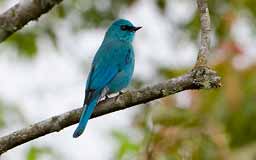 Verditer Flycatcher (Eumyias thalassina)
Verditer Flycatcher (Eumyias thalassina)
 Grey-eyed Bulbul (Iole propinqua)
Grey-eyed Bulbul (Iole propinqua)
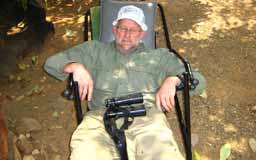 Tom Nap I got pretty wiped out after a lot of birding!
Tom Nap I got pretty wiped out after a lot of birding!
 Tom and Nang Shopping This is just at a roadside food stand.
Tom and Nang Shopping This is just at a roadside food stand.
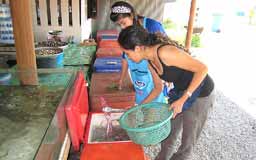 Nang Picking a Squid On our way from Khao Yai to the next site, we stopped at a seafood restaurant where you got to pick out the critters you wanted to eat. Here's Nang selecting a squid.
Nang Picking a Squid On our way from Khao Yai to the next site, we stopped at a seafood restaurant where you got to pick out the critters you wanted to eat. Here's Nang selecting a squid.
 Shrimp Swimming Ellyn took this photo in the shrimp tank of the above-mentioned restaurant.
Shrimp Swimming Ellyn took this photo in the shrimp tank of the above-mentioned restaurant.

There are lots of different "Royal Projects" scattered around Thailand; this was just one near the shore.
 Common Kingfisher (Alcedo atthis) This is such a pretty bird! And it was pretty common!
Common Kingfisher (Alcedo atthis) This is such a pretty bird! And it was pretty common!
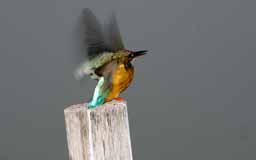 Common Kingfisher (Alcedo atthis) The bird's just starting to take off. I get a lot of these, and I think it's due to the flash's "pre-flash". On digital cameras, the flash flashes a couple of milliseconds before the true flash, and the return is measured to see just how big the "real" flash should be. But I think the birds react to the pre-flash and start to take off. I've had this happen more times than can be ascribed to pure chance.
Common Kingfisher (Alcedo atthis) The bird's just starting to take off. I get a lot of these, and I think it's due to the flash's "pre-flash". On digital cameras, the flash flashes a couple of milliseconds before the true flash, and the return is measured to see just how big the "real" flash should be. But I think the birds react to the pre-flash and start to take off. I've had this happen more times than can be ascribed to pure chance.
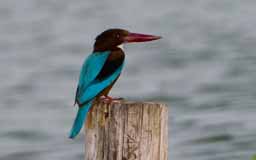 White-throated Kingfisher (Halcyon smyrnensis) Crappy photo, but the one one of this bird.
White-throated Kingfisher (Halcyon smyrnensis) Crappy photo, but the one one of this bird.
 White-breasted Waterhen (Amaurornis phoenicurus)
White-breasted Waterhen (Amaurornis phoenicurus)
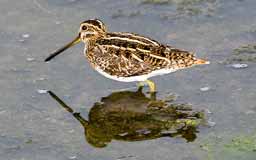 Common Snipe (Gallinago gallinago)
Common Snipe (Gallinago gallinago)
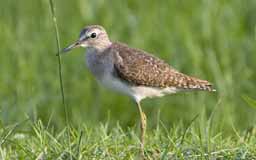 Common Sandpiper (Actitis hypoleucos)
Common Sandpiper (Actitis hypoleucos)
 Chinese Pond Heron (Ardeola bacchus)
Chinese Pond Heron (Ardeola bacchus)
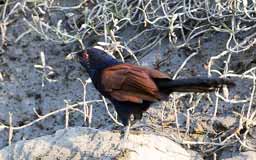 Lesser Coucal (Centropus bengalensis)
Lesser Coucal (Centropus bengalensis)
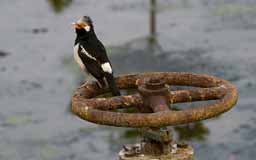 Asian Pied Starling or Pied Mynah (Sturnus contra)
Asian Pied Starling or Pied Mynah (Sturnus contra)
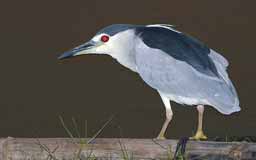 Black-crowned Night Heron (Nycticorax nycticorax) Finally! Here's a bird just like those at home.
Black-crowned Night Heron (Nycticorax nycticorax) Finally! Here's a bird just like those at home.
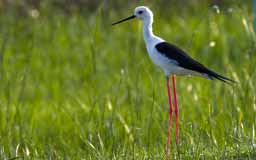 Black-winged Stilt (Himantopus himantopus)
Black-winged Stilt (Himantopus himantopus)
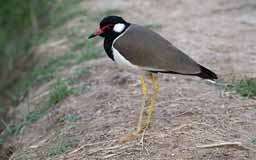 Red-wattled Lapwing (Vanellus indicus)
Red-wattled Lapwing (Vanellus indicus)
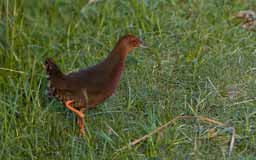 Ruddy-breasted Crake (Porzana fusca)
Ruddy-breasted Crake (Porzana fusca)
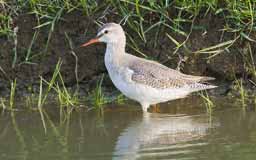 Spotted Redshank (Tringa erythropus)
Spotted Redshank (Tringa erythropus)
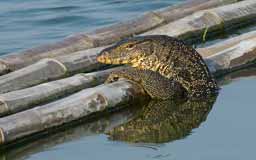 Water Monitor (Varanus salvator) A really cool reptile. They can be pretty big (as large as 2 meters). This beast is in the same genus as the famous Komodo Dragon.
Water Monitor (Varanus salvator) A really cool reptile. They can be pretty big (as large as 2 meters). This beast is in the same genus as the famous Komodo Dragon.

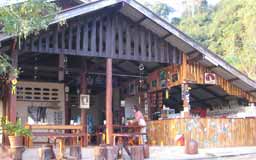 Guest House We stayed in a guest house about two minutes from the park entrance, run by bird enthusiasts. Here's the main house/eating area. I highly recommend this place; the Samarn Bird Camp. They've even got a website: http://www.samarnbirdcamp.com/smarnbirdcamp_eng.htm.
Guest House We stayed in a guest house about two minutes from the park entrance, run by bird enthusiasts. Here's the main house/eating area. I highly recommend this place; the Samarn Bird Camp. They've even got a website: http://www.samarnbirdcamp.com/smarnbirdcamp_eng.htm.While we were birding in this park we ran into a very good German birder named Jörg who had a lot of Thailand birding experience and was looking for a few special birds to complete his list. Since we were looking for those birds as well, we did a lot of birding together, and that was great! He was also good at spotting and identifying birds so we saw even more stuff than we did when we were with Nang alone. It paid off for him, too: Nang had some good ideas of where to find one of his key birds, the Ratchet-tailed Treepie, and after a considerable amount of work, we did find one, and actually got enough good looks that even I was positive I'd seen enough for a positive identification.
 Guest House Here's our room at the guest house.
Guest House Here's our room at the guest house.
 Portrait Here we are, hanging with the guest house owners.
Portrait Here we are, hanging with the guest house owners.
 Female Common Flameback (Dinopium javanense) Taken at a place near the guest house where they had a blind for birders and photographers.
Female Common Flameback (Dinopium javanense) Taken at a place near the guest house where they had a blind for birders and photographers.
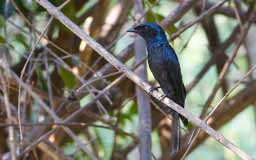 Asian Fairy Bluebird (Irena puella)
Asian Fairy Bluebird (Irena puella)
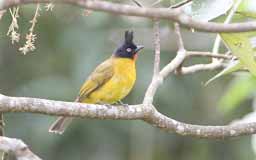 Black-crested Bulbul (Pycnonotus melanicterus)
Black-crested Bulbul (Pycnonotus melanicterus)
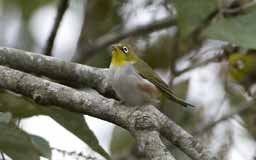 Chestnut-flanked White-eye (Zosterops erythropleurus)
Chestnut-flanked White-eye (Zosterops erythropleurus)
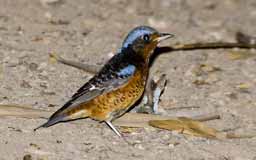 White-throated Rock Thrush (Monticola gularis) This fairly rare bird was just sitting on the road on our early-morning drive into the park. I got this quick snapshot from too far away in the darkness and the photo still turned out to be recognizable.
White-throated Rock Thrush (Monticola gularis) This fairly rare bird was just sitting on the road on our early-morning drive into the park. I got this quick snapshot from too far away in the darkness and the photo still turned out to be recognizable.
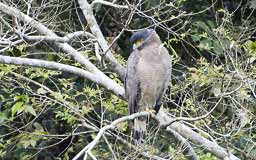 Crested Serpent Eagle (Spilornis cheela) What was totally annoying about this particular bird is that he (she?) sat still forever, but was very difficult to approach due to the tangle of jungle between me and it. And no matter how I tried to find a better shooting location, the bird managed to keep a small stick in front of its face. Here's my best shot, stick included. (Click on the image for a better look.)
Crested Serpent Eagle (Spilornis cheela) What was totally annoying about this particular bird is that he (she?) sat still forever, but was very difficult to approach due to the tangle of jungle between me and it. And no matter how I tried to find a better shooting location, the bird managed to keep a small stick in front of its face. Here's my best shot, stick included. (Click on the image for a better look.)
When you shoot birds or animals, it's always important to get the eye in focus. That's what viewers look for first, and a sharply-focused eye can make up for an otherwise bad photo. In this case, the damn stick always seemed to be in front of the eye.
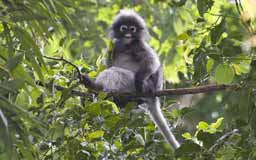 Dusky Langur (Trachypithecus obscurus) What a cutie-pie!
Dusky Langur (Trachypithecus obscurus) What a cutie-pie!
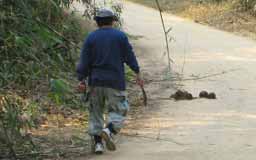 Elephant Poo There was a lot of evidence for elephants, but we never saw them in the wild. Here's some poop, and we saw tracks as well (next slide). There were a lot of ripped-down plants where the elephants had crossed the roads.
Elephant Poo There was a lot of evidence for elephants, but we never saw them in the wild. Here's some poop, and we saw tracks as well (next slide). There were a lot of ripped-down plants where the elephants had crossed the roads.
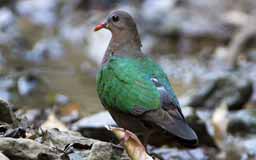 Emerald Dove (Chalcophaps indica)
Emerald Dove (Chalcophaps indica)
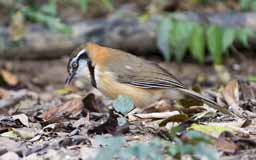 Lesser Necklaced Laughingthrush (Garrulax monileger)
Lesser Necklaced Laughingthrush (Garrulax monileger)
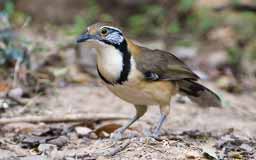 Greater Necklaced Laughingthrush (Garrulax pectoralis)
Greater Necklaced Laughingthrush (Garrulax pectoralis)
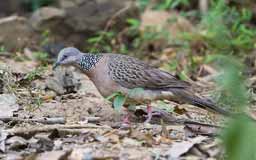 Spotted Dove (Streptopelia chinensis) I got this photo, and a few others, when the owner of the guest house invited me to spend 4 hours with him in a blind in the park. He was an avid photographer. Unfortunately, although we saw some stuff during the 4 hours, we didn't see the bird we were hoping for, the Grey Peacock Pheasant.
Spotted Dove (Streptopelia chinensis) I got this photo, and a few others, when the owner of the guest house invited me to spend 4 hours with him in a blind in the park. He was an avid photographer. Unfortunately, although we saw some stuff during the 4 hours, we didn't see the bird we were hoping for, the Grey Peacock Pheasant.
We had a good time, although we couldn't speak a word of any language in common, but we were both nut-case photographers. It was ok, since we wanted to be almost totally quiet anyway. It was a little weird to hear bizarre sounds behind us and not be able to see what was causing them since the blind was completely closed.
The poor guy wanted to smoke, but apparently Nang had told him not to do so with her guests. I figured I could take second-hand smoke from a cigarette or two since it probably takes hundreds of thousands of direct inhalations to cause cancer and it'll take 20 years to kill me, by which time I'll probably be senile anyway. When I indicated that he could go ahead and smoke I may have made a friend for life.
He's Samarn, of the Samarn Bird Camp guest house.
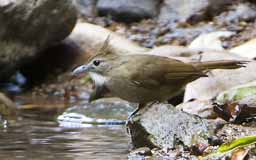 Ochraceous Bulbul (Alophoixus ochraceus)
Ochraceous Bulbul (Alophoixus ochraceus)
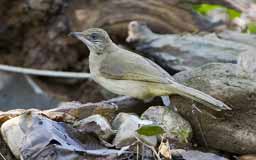 Streak-eared Bulbul (Pycnonotus blanfordi)
Streak-eared Bulbul (Pycnonotus blanfordi)
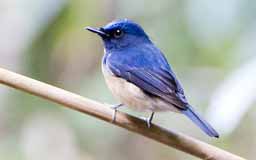 Siberian Blue Robin (Luscinia cyane)
Siberian Blue Robin (Luscinia cyane)
 Old Men Here I am with Samarn, the owner of the guest house; we're looking at some of the photos he got during our time in the blind.
Old Men Here I am with Samarn, the owner of the guest house; we're looking at some of the photos he got during our time in the blind.
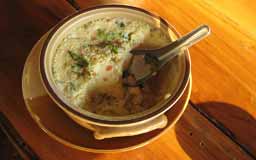 Whipped Eggs The folks at the guest house invented a new breakfast and asked our advice for a name to use on the menu. It was eggs, whipped up, and mixed with some veggies. We suggested "whipped eggs".
Whipped Eggs The folks at the guest house invented a new breakfast and asked our advice for a name to use on the menu. It was eggs, whipped up, and mixed with some veggies. We suggested "whipped eggs".
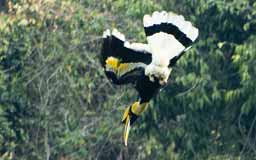 Great Hornbill (Buceros bicornis) We spent about a half-hour trying to get photos of these birds in flight. We did have a few opportunities, since there was a pair busy building a nest here.
Great Hornbill (Buceros bicornis) We spent about a half-hour trying to get photos of these birds in flight. We did have a few opportunities, since there was a pair busy building a nest here.
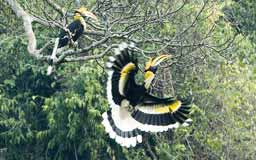 Great Hornbill (Buceros bicornis)
Great Hornbill (Buceros bicornis)
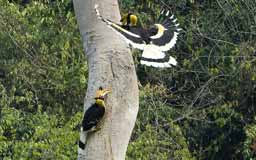 Great Hornbill (Buceros bicornis)
Great Hornbill (Buceros bicornis)
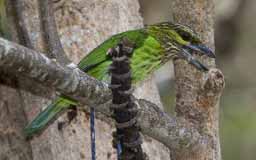 Green-eared Barbet (Megalaima faiostricta)
Green-eared Barbet (Megalaima faiostricta)
 Male Kalij Pheasant (Lophura leucomelanos) This is pretty similar to the Silver Pheasant, but it does look a bit different. And at least some folks give it a different scientific name, so maybe it's a different species. I got these photos in a blind near the guest house.
Male Kalij Pheasant (Lophura leucomelanos) This is pretty similar to the Silver Pheasant, but it does look a bit different. And at least some folks give it a different scientific name, so maybe it's a different species. I got these photos in a blind near the guest house.
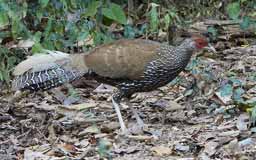 Female Kalij Pheasant (Lophura leucomelanos)
Female Kalij Pheasant (Lophura leucomelanos)
 Leech On one of the hikes, there were leeches. Here's a shot of one connected to Ellyn's leg. You couldn't feel them at all since they inject a sort of anesthetic when they hook on; the next photo shows what happens if you allow one to "dine" for a couple of minutes. They also inject an anti-coagulant, so even if you pull them off, you continue to bleed like a stuck pig. You can see the leech on the outside of my sock if you look at the full-sized image!
Leech On one of the hikes, there were leeches. Here's a shot of one connected to Ellyn's leg. You couldn't feel them at all since they inject a sort of anesthetic when they hook on; the next photo shows what happens if you allow one to "dine" for a couple of minutes. They also inject an anti-coagulant, so even if you pull them off, you continue to bleed like a stuck pig. You can see the leech on the outside of my sock if you look at the full-sized image!
It's totally amazing how fast the leeches were in finding open flesh (or a path through your sock), connecting, and starting to suck. They apparently don't carry any important diseases, so most of the locals just live with them. I was pretty freaked out at first, however.
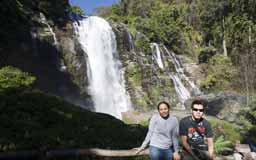 Nang and Ahn Here are Nang and Ahn (the driver) near a waterfall we visited.
Nang and Ahn Here are Nang and Ahn (the driver) near a waterfall we visited.
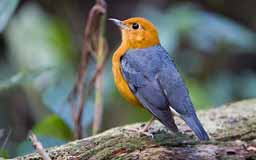 Orange-headed Thrush (Zoothera citrina) This guy just sat on a log as I slowly moved closer and closer, getting better photos each time.
Orange-headed Thrush (Zoothera citrina) This guy just sat on a log as I slowly moved closer and closer, getting better photos each time.
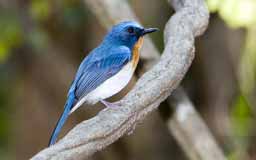 Tickell's Blue Flycatcher (Cyornis tickelliae)
Tickell's Blue Flycatcher (Cyornis tickelliae)
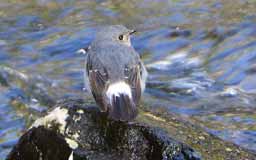 Plumbeous Water Redstart (Rhyacornis fuliginosa)
Plumbeous Water Redstart (Rhyacornis fuliginosa)
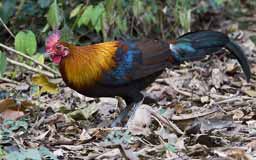 Male Red Junglefowl (Gallus gallus) Yup, this is just a rooster, but roosters and chickens are native to Thailand, and these are wild birds, so as birders, we can "count" them on our lists.
Male Red Junglefowl (Gallus gallus) Yup, this is just a rooster, but roosters and chickens are native to Thailand, and these are wild birds, so as birders, we can "count" them on our lists.
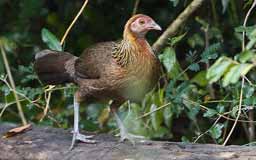 Female Red Junglefowl (Gallus gallus)
Female Red Junglefowl (Gallus gallus)
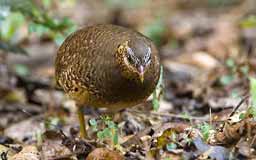 Scaly-breasted Partridge (Arborophila chloropus) Another rare find!
Scaly-breasted Partridge (Arborophila chloropus) Another rare find!
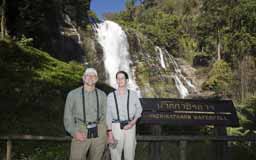 Tom and Ellyn at Vachiratharn Waterfall
Tom and Ellyn at Vachiratharn Waterfall
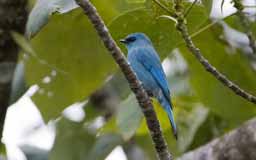 Verditer Flycatcher (Eumyias thalassina)
Verditer Flycatcher (Eumyias thalassina)
 Buddha This is a huge statue of Buddha up on a hill. Way below him is a temple with smaller images of Buddha, as in the photo below.
Buddha This is a huge statue of Buddha up on a hill. Way below him is a temple with smaller images of Buddha, as in the photo below.

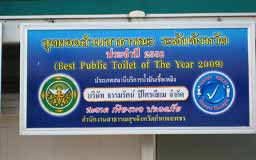 ...but the Best Toilet: Best Public Toilet of the year! Of course that was back in 2009 and we visited in 2010. Maybe we missed it at its peak?
...but the Best Toilet: Best Public Toilet of the year! Of course that was back in 2009 and we visited in 2010. Maybe we missed it at its peak?
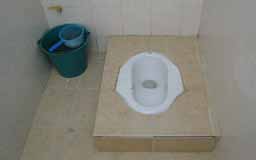 Toilet Here's a toilet where you stand on the foot rests and poop/pee.
Toilet Here's a toilet where you stand on the foot rests and poop/pee.
 Toilet This one is more typical. A normal toilet, but no mechanism to flush it. Instead, you scoop water from the clay bowl directly into the toilet bowl. You can use the spray attachment as a sort of douche to clean up.
Toilet This one is more typical. A normal toilet, but no mechanism to flush it. Instead, you scoop water from the clay bowl directly into the toilet bowl. You can use the spray attachment as a sort of douche to clean up.
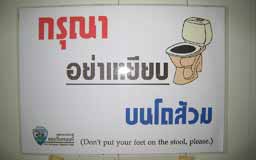 Toilet I don't know what this means. I hope "stool" refers to something you normally stand or sit on!
Toilet I don't know what this means. I hope "stool" refers to something you normally stand or sit on!
OK, after reading this, Chris sends the translation and reason:
"The sign says 'Don't stand on the toilet' because so many villagers have never seen a sit toilet before and have no idea what to do with it. They will invariably leave tell-tale dirt shoe impressions on the seat as they try to precariously squat at high altitude and do their business."

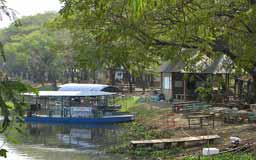 Boat Launch Unfortunately, I didn't get any photos of the drive trains of these boats. All were the same; automobile engines stripped down and with a long rod (2 or 3 meters) connecting the engine to the propeller. They unfortunately made a lot of noise, so getting photos of birds in flight almost always resulted in a "cloacal view". With a lot more time, it would have been fun (photographically, at least) to drive out into the lake/swamp, turn off the engine, and just wait patiently for something to happen. Of course you'd see fewer birds this way, but better views of some of them.
Boat Launch Unfortunately, I didn't get any photos of the drive trains of these boats. All were the same; automobile engines stripped down and with a long rod (2 or 3 meters) connecting the engine to the propeller. They unfortunately made a lot of noise, so getting photos of birds in flight almost always resulted in a "cloacal view". With a lot more time, it would have been fun (photographically, at least) to drive out into the lake/swamp, turn off the engine, and just wait patiently for something to happen. Of course you'd see fewer birds this way, but better views of some of them.
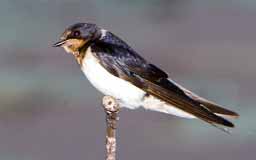 Barn Swallow (Hirundo rustica) Just like at home...
Barn Swallow (Hirundo rustica) Just like at home...
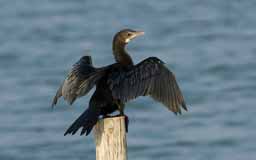 Indian Cormorant (Phalacrocorax fuscicollis)
Indian Cormorant (Phalacrocorax fuscicollis)
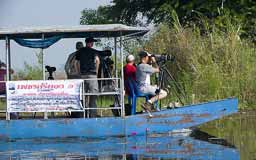 Photographers There were a few boats of folks doing exactly what I was!
Photographers There were a few boats of folks doing exactly what I was!
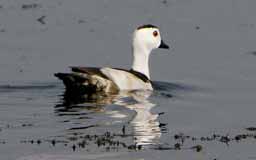 Cotton Pygmy-goose (Nettapus coromandelianus)
Cotton Pygmy-goose (Nettapus coromandelianus)
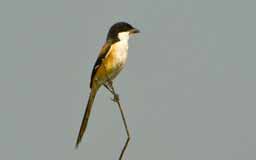 Long-tailed Shrike (Lanius schach)
Long-tailed Shrike (Lanius schach)
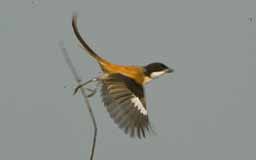 Long-tailed Shrike (Lanius schach)
Long-tailed Shrike (Lanius schach)
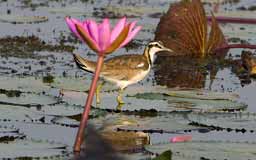 Pheasant-tailed Jacana (Hydrophasianus chirurgus) This bird is apparently wildly different in breeding season, and the males illustrate why they're called "pheasant-tailed."
Pheasant-tailed Jacana (Hydrophasianus chirurgus) This bird is apparently wildly different in breeding season, and the males illustrate why they're called "pheasant-tailed."
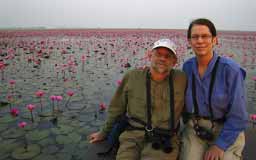 Ellyn and Tom among the lily pads
Ellyn and Tom among the lily pads
 Intermediate Egret (Ardea intermedia)
Intermediate Egret (Ardea intermedia)
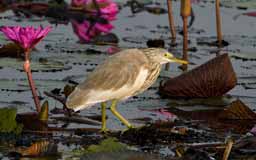 Javan Pond Heron (Ardeola speciosa)
Javan Pond Heron (Ardeola speciosa)
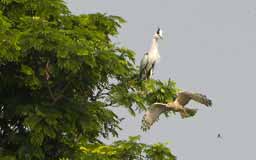 Eastern Marsh Harrier (Circus spilonotus) ... plus a Grey Heron and even a tiny Barn Swallow!
Eastern Marsh Harrier (Circus spilonotus) ... plus a Grey Heron and even a tiny Barn Swallow!
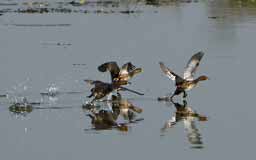 Lesser Whistling Ducks (Dendrocygna javanica)
Lesser Whistling Ducks (Dendrocygna javanica)
 Lesser Whistling Ducks (Dendrocygna javanica)
Lesser Whistling Ducks (Dendrocygna javanica)
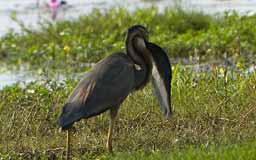 Purple Heron (Ardea purpurea) with Fish Look at the size of the fish and the size of the heron. He did get it down, though!
Purple Heron (Ardea purpurea) with Fish Look at the size of the fish and the size of the heron. He did get it down, though!
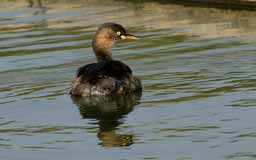 Little Grebe (Tachybaptus ruficollis)
Little Grebe (Tachybaptus ruficollis)
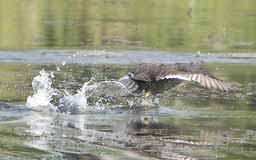 Little Grebe (Tachybaptus ruficollis) ...I think... Takeoff
Little Grebe (Tachybaptus ruficollis) ...I think... Takeoff
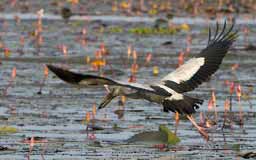 Asian Openbill (Anastomas oscitans)
Asian Openbill (Anastomas oscitans)
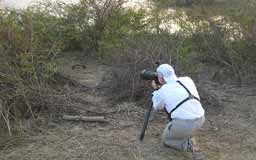 Tom set up for a photo The guides knew that a Siberian Rubythroat lived nearby, so every day they feed it with a few mealworms at this site. It's not an easy bird to find normally, so I'll bet that if you did a Google image search for this bird, you'd find a lot of photos of the little perch my camera's pointing at.
Tom set up for a photo The guides knew that a Siberian Rubythroat lived nearby, so every day they feed it with a few mealworms at this site. It's not an easy bird to find normally, so I'll bet that if you did a Google image search for this bird, you'd find a lot of photos of the little perch my camera's pointing at.
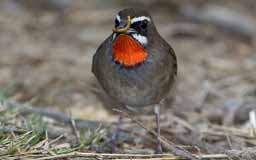 Siberian Rubythroat (Luscinia calliope) ...with one of the mealworms in its mouth.
Siberian Rubythroat (Luscinia calliope) ...with one of the mealworms in its mouth.
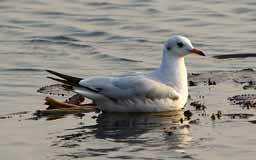 Black-headed Gull (Chroicocephalus ridibundus)
Black-headed Gull (Chroicocephalus ridibundus)
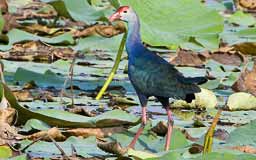 Purple Swamphen (Porphyrio porphyrio)
Purple Swamphen (Porphyrio porphyrio)
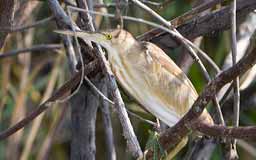 Yellow Bittern (Ixobrychus sinensis)
Yellow Bittern (Ixobrychus sinensis)

 High Point Here we are, at the top of Thailand! Even though we were in the tropics, it was pretty chilly here at the crack of dawn.
High Point Here we are, at the top of Thailand! Even though we were in the tropics, it was pretty chilly here at the crack of dawn.
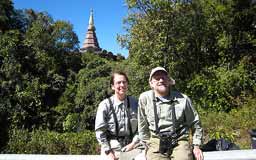 Tom and Ellyn with a Wat (temple) above. This is just one of two similar wats built next to each other, apparently by the Thai airforce. The area is surrounded by beautifully-manicured gardens.
Tom and Ellyn with a Wat (temple) above. This is just one of two similar wats built next to each other, apparently by the Thai airforce. The area is surrounded by beautifully-manicured gardens.
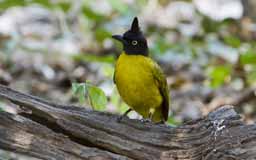 Black-crested Bulbul (Pycnonotus melanicterus)
Black-crested Bulbul (Pycnonotus melanicterus)
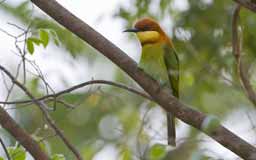 Chestnut-headed Bee-eater (Merops leschenaulti)
Chestnut-headed Bee-eater (Merops leschenaulti)
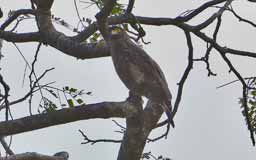 Crested Serpent Eagle (Spilornis cheela)
Crested Serpent Eagle (Spilornis cheela)
 Crested Serpent Eagle (Spilornis cheela)
Crested Serpent Eagle (Spilornis cheela)
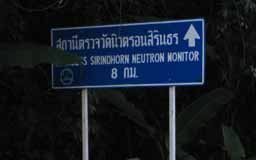 Neutron Monitor I don't know what a "neutron monitor" is, but maybe it's related to the spherical building below? It was illegal to take the photo below, of course, due to national security, so maybe I can never go to Thailand again for fear of arrest. We were in a hurry, so Ellyn just got this snapshot of the sign. The obscured word is "Princess".
Neutron Monitor I don't know what a "neutron monitor" is, but maybe it's related to the spherical building below? It was illegal to take the photo below, of course, due to national security, so maybe I can never go to Thailand again for fear of arrest. We were in a hurry, so Ellyn just got this snapshot of the sign. The obscured word is "Princess".
 Sphere Related to geodesic domes, but a complete sphere. Note, however, that the lengths aren't all the same, as they would be in Buckminster Fuller's creations.
Sphere Related to geodesic domes, but a complete sphere. Note, however, that the lengths aren't all the same, as they would be in Buckminster Fuller's creations.
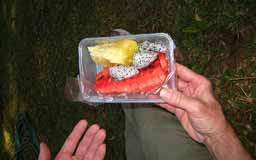 Breakfast Fruit To get to birding sites early enough, we often skipped breakfast and ate out of tupperware like this. The same for lunches.
Breakfast Fruit To get to birding sites early enough, we often skipped breakfast and ate out of tupperware like this. The same for lunches.
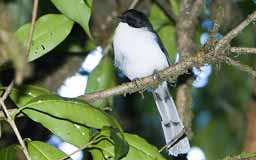 Dark-backed Sibia (Heterophasia melanoleuca)
Dark-backed Sibia (Heterophasia melanoleuca)
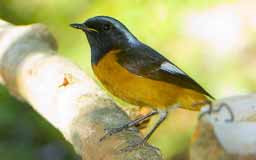 Daurian Redstart (Phoenicurus auroreus)
Daurian Redstart (Phoenicurus auroreus)
 Golden-fronted Leafbird (Chloropsis aurifrons) The "leafbird" name struck us as really funny. In the neotropical parts of Central/South America in the deep forest, you often see movement that looks like a bird. But when you focus on it, it's just a leaf in the wind. We jokingly call them "leafbirds." There are "green leafbirds" and "brown leafbirds". There are also "stickbirds", usually brown. In Asia, there are real leafbirds, of which we saw quite a few different types.
Golden-fronted Leafbird (Chloropsis aurifrons) The "leafbird" name struck us as really funny. In the neotropical parts of Central/South America in the deep forest, you often see movement that looks like a bird. But when you focus on it, it's just a leaf in the wind. We jokingly call them "leafbirds." There are "green leafbirds" and "brown leafbirds". There are also "stickbirds", usually brown. In Asia, there are real leafbirds, of which we saw quite a few different types.
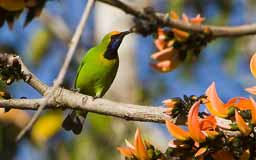 Golden-fronted Leafbird (Chloropsis aurifrons)
Golden-fronted Leafbird (Chloropsis aurifrons)
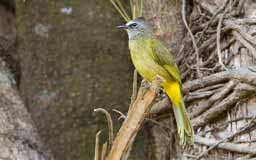 Flavescent Bulbul (Pycnonotus flavescens)
Flavescent Bulbul (Pycnonotus flavescens)
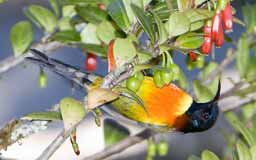 Green-tailed Sunbird (Aethopyga nipalensis) I was taking a photo of this bird when an older man walked past, said something in German, then instantly switched to English. He was with his young Thai wife and baby and joked that I should take a picture of the kid instead since the kid was far more beautiful. We saw him a bit later eating an ice-cream cone. We commented that it was pretty chilly for ice-cream and he replied that he'd just come over from Norway in winter and was over-heating.
Green-tailed Sunbird (Aethopyga nipalensis) I was taking a photo of this bird when an older man walked past, said something in German, then instantly switched to English. He was with his young Thai wife and baby and joked that I should take a picture of the kid instead since the kid was far more beautiful. We saw him a bit later eating an ice-cream cone. We commented that it was pretty chilly for ice-cream and he replied that he'd just come over from Norway in winter and was over-heating.
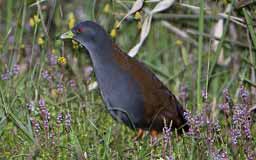 Black-tailed Crake (Amaurornis bicolor) There were actually three of them at this site, almost always well-hidden in bushes. But I could set up nearby and wait, and since somebody was leaving a few mealworms just out in the open, the three crakes came out from time to time, ate quickly, and then hurried back for cover. I got a lot of chances at them and this is my best. It was late in the day, and although the crakes got less and less skittish, there was also less and less light.
Black-tailed Crake (Amaurornis bicolor) There were actually three of them at this site, almost always well-hidden in bushes. But I could set up nearby and wait, and since somebody was leaving a few mealworms just out in the open, the three crakes came out from time to time, ate quickly, and then hurried back for cover. I got a lot of chances at them and this is my best. It was late in the day, and although the crakes got less and less skittish, there was also less and less light.
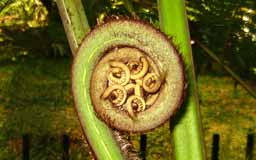 Fractal-like fern This, and the next two photos, were taken in a Royal Garden which was inside the park, huge, and amazingly well-maintained.
Fractal-like fern This, and the next two photos, were taken in a Royal Garden which was inside the park, huge, and amazingly well-maintained.
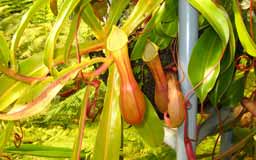 Bug Eater A carnivorous plant. At the gardens in Doi Inthanon there was a large exhibition of these. The ones above reminded me of the California Pitcher Plants (family Darlingtonia) but they also had Venus Flytrap plants and others that I never seen anything like before.
Bug Eater A carnivorous plant. At the gardens in Doi Inthanon there was a large exhibition of these. The ones above reminded me of the California Pitcher Plants (family Darlingtonia) but they also had Venus Flytrap plants and others that I never seen anything like before.
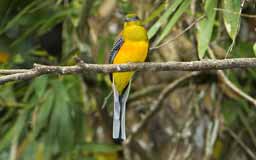 Orange-breasted Trogon (Harpactes oreskios)
Orange-breasted Trogon (Harpactes oreskios)
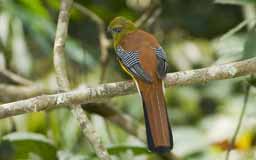 Orange-breasted Trogon (Harpactes oreskios)
Orange-breasted Trogon (Harpactes oreskios)
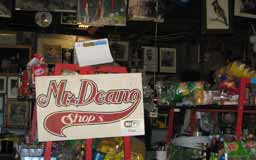 Mr. Deang A guest-house/restaurant run by an avid birder, Mr. Deang. It's set up so you need to have your binoculars next to you as you eat.
Mr. Deang A guest-house/restaurant run by an avid birder, Mr. Deang. It's set up so you need to have your binoculars next to you as you eat.
 Plumbing Here's some of Mr. Deang's plumbing.
Plumbing Here's some of Mr. Deang's plumbing.
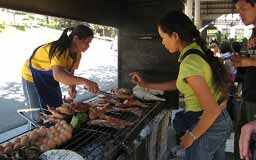 Nang Selecting a Fish Here's an interesting meal: a fish cooked in a salt encasement. The salt is perhaps a half-centimeter thick, and it's just roasted on a barbeque. As you can see in the photos below, it's quite a chunk of salt that's removed. Inside the fish's body are a bunch of seasoning herbs. The meat was very tender, but a "bit" salty.
Nang Selecting a Fish Here's an interesting meal: a fish cooked in a salt encasement. The salt is perhaps a half-centimeter thick, and it's just roasted on a barbeque. As you can see in the photos below, it's quite a chunk of salt that's removed. Inside the fish's body are a bunch of seasoning herbs. The meat was very tender, but a "bit" salty.
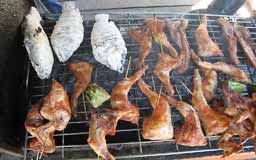 Salted Fish ... and other stuff on the "barbie," including roasted eggs (which are not visible in this photo -- you can see them in the previous photo). I wish we'd tried one of the eggs to see how different they are from our usual hard-boiled variety.
Salted Fish ... and other stuff on the "barbie," including roasted eggs (which are not visible in this photo -- you can see them in the previous photo). I wish we'd tried one of the eggs to see how different they are from our usual hard-boiled variety.
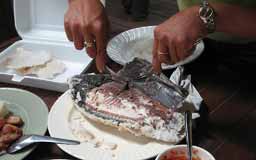 Salted Fish Serve Here's Nang, serving the fish. Note the chunks of salt that have been removed.
Salted Fish Serve Here's Nang, serving the fish. Note the chunks of salt that have been removed.
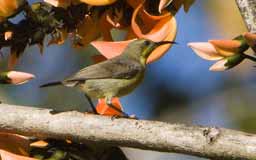 Female Purple Sunbird (Nectarinia asiatica) I never got a good photo of the male which is where the "Purple" in the name comes from.
Female Purple Sunbird (Nectarinia asiatica) I never got a good photo of the male which is where the "Purple" in the name comes from.
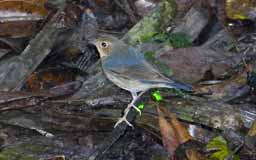 Immature Siberian Blue Robin (Luscinia cyane) Notice how different this one looks from the previous photo of the Siberian Blue Robin taken earlier in Kaeng Krachan.
Immature Siberian Blue Robin (Luscinia cyane) Notice how different this one looks from the previous photo of the Siberian Blue Robin taken earlier in Kaeng Krachan.
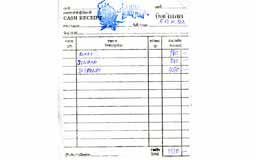 Ronry This was our bill for extras at the birding lodge we stayed at near Doi Inthanon. It took us a while to figure out that "ronry" is "laundry" in Engrish. You can also see that we were a bit lax in our alcohol consumption: three nights and only 8 beers.
Ronry This was our bill for extras at the birding lodge we stayed at near Doi Inthanon. It took us a while to figure out that "ronry" is "laundry" in Engrish. You can also see that we were a bit lax in our alcohol consumption: three nights and only 8 beers.
 Wat We stopped at this wat on our way to Pai and got this and the following few photos.
Wat We stopped at this wat on our way to Pai and got this and the following few photos.
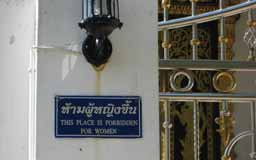 No Women Women's lib hasn't caught on here yet.
No Women Women's lib hasn't caught on here yet.
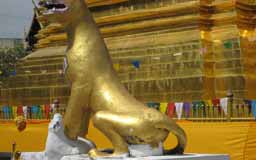 Lion Nuts Check the lower-right end of the lion.
Lion Nuts Check the lower-right end of the lion.

It's also a popular destination for Thai people from Bangkok as well, and it was apparently made wildly popular there by a couple of movies that took place there. According to my friend Chris, you can almost always find visitors going to the exact locations where various movie scenes were shot and doing the exact things that the actors did: mail a postcard from a certain postcard shop to yourself at home, for example. They also would always take a photo of themselves in front of those same places.
Chris' site has a lot of pages on Thailand and particularly about Pai, and you can find links to them here: http://lurkertech.com/. There's a lot of other interesting stuff on that page as well.
Pai is supposed to be totally "laid back", and that was surely my experience. It was great for a few days, but I think I'd get pretty tired of it after too long. We stayed at the Ing Doi Guesthouse, which I would certainly recommend. One surprising feature of the guesthouse (and Pai in general) was just how cold it got at night. There's no air conditioning, but you really don't need it.
One of the popular activities in the afternoons for some of the local farangs ("farang" is the Thai equivalent of "gringo" -- it refers to a European or American, usually) is to have tea at a long table in front of the local Muslim bakery, and we did this a couple of times, and met some of the other residents. One topic that came up over and over was that of a marriage between a Thai woman and a farang.
Apparently this happens a lot, since farangs are generally quite wealthy in Thai terms. Very often, the marriage is between an old, fat, ugly farang and a young good-looking Thai woman. I got the impression that these marriages hardly ever worked out well, although some do. The woman gets access to the money, although she's stuck with a farang, and the man winds up with not only a beautiful young woman, but also her entire family which he is now expected to support monetarily.
There was also a discussion of a bunch of weddings between farangs and members of one of the local hill tribes (called the "Lisu" people) where there were quite a few examples of the men not living as long as expected. Then we talked about a recent marriage between a really fat, unhealthy guy to a Lisu girl who was trained as a nurse. I made some comment that marrying a nurse was probably a good idea if you were likely to have a heart attack or stroke due to your unhealthy habits, but I was assured that all such marriages are "DNR" ("Do Not Resuscitate").
In fact, most of the meals we ate in Thailand were quite good, and not too much different from what we get in Thai restaurants at home. Nang was worried that some of the stuff might be too hot, but we're used to spicy food at home, and there was nothing that was far out of the ordinary along those lines. One difference I noted (and it may help account for the fact that there's almost no obesity in Thailand) is that for extra flavor, the chicken, fish, pork, shrimp, et cetera, was usually cooked with the bones or shells. This slows you down quite a bit during meals, and probably prevents over-eating, since when you eat more slowly, your body has more time to report to your brain that you're full.
The most unusual meal we had was a specialty called "red ant (something)". It's made with red ant eggs and larvae. Apparently there's some species of ants with an above-ground nest that can be chopped open and all the ants, eggs, and larvae fall into a pot of water. A piece of cloth is dragged through the water and the adult ants grab onto it and are pulled out, leaving only eggs and larvae. Those are cooked into a sort of stew with some other stuff. It was a little weird to eat it, since it was obvious what we were eating, but it didn't taste bad (or particularly good, either). In any case, at least I've got a good food story from the trip.
 Muddy Road We stopped to check to see if Nang's uncle's car could make it through the mud. Nang, unfortunately, got too hot and took off her outer shirt. But when she did, she left her fanny pack on a fence and we drove off without it. She figured it out within minutes, but when we returned, it was gone. It was a total disaster for her; she lost her ID card, her passport, most of her money, her credit card, her bank card, and her guide's license.
Muddy Road We stopped to check to see if Nang's uncle's car could make it through the mud. Nang, unfortunately, got too hot and took off her outer shirt. But when she did, she left her fanny pack on a fence and we drove off without it. She figured it out within minutes, but when we returned, it was gone. It was a total disaster for her; she lost her ID card, her passport, most of her money, her credit card, her bank card, and her guide's license.
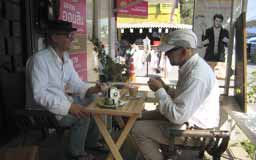 Tom and Paul A laid-back cup of coffee with my good friend Paul.
Tom and Paul A laid-back cup of coffee with my good friend Paul.
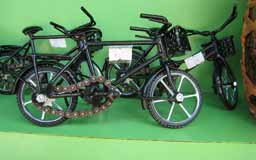 Mini Bikes Trinkets in a Pai store for tourists.
Mini Bikes Trinkets in a Pai store for tourists.
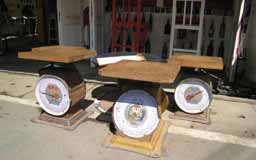 Scale Seats You can tell right away in this restaurant if you've over-eaten!
Scale Seats You can tell right away in this restaurant if you've over-eaten!
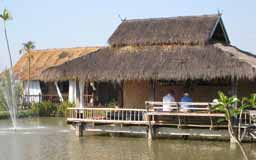 Tom and Paul at Lunch At a lunch place in Pai with the whole crew.
Tom and Paul at Lunch At a lunch place in Pai with the whole crew.
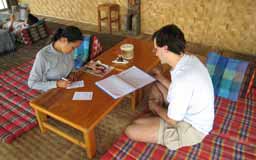 Chris and Nang Ordering lunch.
Chris and Nang Ordering lunch.
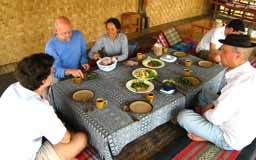 A Lazy Lunch The next few slides show some of the dishes we ate that day.
A Lazy Lunch The next few slides show some of the dishes we ate that day.
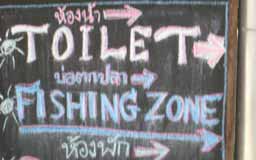 Toilet Fishing An unfortunate sentence collision.
Toilet Fishing An unfortunate sentence collision.
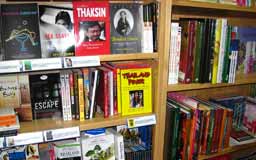 Thailand Fever Here's Chris's book on Thai/western romantic relationships (always between a Thai female and a farang male), for sale at the Chiang Mai airport.
Thailand Fever Here's Chris's book on Thai/western romantic relationships (always between a Thai female and a farang male), for sale at the Chiang Mai airport.
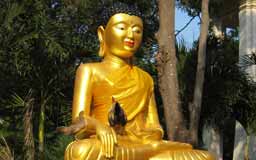 Gold Buddha The final slide in the slide show.
Gold Buddha The final slide in the slide show.
 Waterfall An alternative final slide.
Waterfall An alternative final slide.


This turns out to be a total nightmare, since the check-in counter is on the other side of quarantine, immigration and customs. We had to fill out all the forms for our "visit" to Japan, pass all the way out of the system, and then return by reversing our path. The "helpful" instructions said to allow 3 hours, and we had 1.5 hours before our next flight.
Luckily, things went smoothly, and I could tell that the folks in immigration and customs saw this far too often, and they sped us through. But what a pain in the ass!
When I got home and was no longer freaked out or jet-lagged, I figured out that if I had simply unscrewed and removed the bottom segment from each leg, the resulting package was only 59 centimeters.
Oh well, at least we now have "Japan" entry and exit stamps in our passports.
Visit my Home Page.
Want to send me mail? Click here: tomrdavis@earthlink.net.